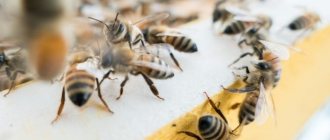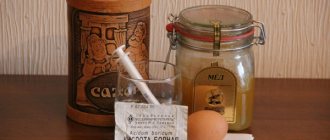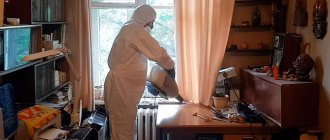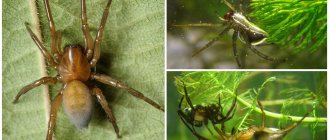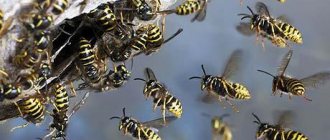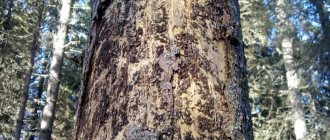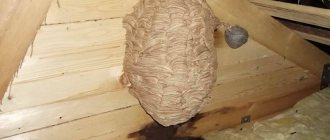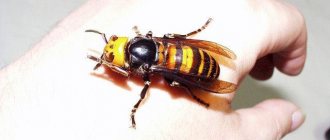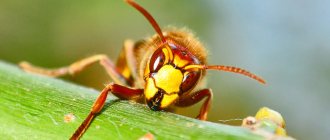Over the past summer and early autumn, our guys destroyed 118 wasp nests in Moscow, the Moscow region, St. Petersburg and the Leningrad region. On average, this turns out to be approximately one nest per day, but in reality, the destruction of wasps is required mainly in August-September, when there are a lot of them in each nest and they appear en masse in dachas, vegetable gardens, or even in courtyards within the city.
On some August days we carried out 3-4 “deosizations” per day. This is, for example, what the nest looks like, which Zhenya removed from a decorative thuja on a plot in Ramenskoye:
By the way, during the entire period of SanMariDez’s work, we had 740 visits to exterminate wasps. We were bitten, whole swarms flew after us, sometimes we even dropped nests with angry insects. Moreover, approximately every fifteenth nest in our practice is a nest of hornets (they are also wasps), and working with them is especially extreme.
In general, we have learned how to destroy wasps. And now we’ll tell you how to do it so that this special operation is quick, simple and, most importantly, safe. Here you need to act step by step.
Burn the nest
This method is suitable if the wasps have settled in a hole in the ground, or their nest hangs on a stone wall or on a stone ceiling, and the flame from it will not lead to a fire. In this case, you can simply pour gasoline into the hole, and to burn a hanging nest, you can fill a container with a sprayer with gasoline, kerosene, or fire starter, spray it several times on the nest (or simply spray it from a bottle for lack of a sprayer) and immediately light it with a lighter. It will burn very quickly, in a few minutes, with all the wasps that are inside it.
The video below shows how a hornets' nest is burned using a gas torch:
This method is as simple as it is dangerous due to the risk of starting a fire. It cannot be used if the nest is located indoors, in the roof, in the wall of a house, or in dense bushes.
Here is an example from a news chronicle about an American who decided to burn a wasp nest under the roof of his barn:
Security measures
As already mentioned, destroying a nest and the wasps inhabiting it is a rather dangerous undertaking, since if something goes wrong in this process, then a person will be confronted by a large number of aggressive insects who want to protect their home.
For this reason, it would be a good idea to take care of some security measures; below are some important tips related to this issue:
- Wear clothing made of thick fabric so that insects cannot sting through it. It is highly recommended to have a hood that will additionally protect your head.
- Gloves must be worn on your hands; varieties made of leather or thick rubber are best.
- The face should be covered with a special mosquito net mask, since bites to this part of the body are considered the most dangerous.
- Have pre-prepared ice, a tourniquet and anti-allergic drugs, for example, suprastin, which will be needed if the wasp does manage to sting a person.
Drown the nest
This is a suitable option if the nest is hanging on a level, flat ceiling. In this case, water is poured to the brim into a bucket whose diameter is greater than the diameter of the nest, and a board is selected, the length of which will allow you to support the bucket attached to the ceiling. Then the bucket is raised so that the nest is immersed in water, pressed against the ceiling and supported from below by a board. This method is good for its safety, but it is rarely used, since the nest rarely hangs on a flat ceiling.
A variant of this method, suitable for destroying a nest in the ground, is to pour a large amount of water into the hole (preferably from a hose), and when water begins to flow out of the hole, close the entrance to the hole with a large stone.
Hatching rules
When a nest is discovered and it is established that it is located in close proximity to residential or domestic buildings, as well as simply places where people often visit, then its destruction is required.
However, removing wasps is a complex and dangerous process, when performing it you must remember the following rules:
- It is strictly forbidden to use fire to remove wasps and destroy a nest if it is located on a tree, a wooden structure, or in close proximity to flammable materials.
- It is also undesirable to use gasoline or kerosene for removal in these places , even if it is not planned to be set on fire, since this will contribute to the creation of dangerous conditions.
- Provide protective clothing in advance , since if an attempt to destroy the nest is unsuccessful, its inhabitants will show the maximum degree of aggression.
- Before removing wasps, warn all neighbors and people living nearby about the planned event , so that they keep their windows closed at this time and try to refrain from going outside.
- Choose the most appropriate and safety compliant method for removing the wasp nest.
Kill all wasps with insecticide and simply remove the nest
This is the safest, most reliable method that works in absolutely all cases. This is actually why professional exterminators use it. It is implemented simply: the nest is intensively sprayed with an insecticide solution from a special sprayer, which allows you to literally water the entire structure with poison. All wasps that fall under the spray of insecticide die within a few minutes; many of them do not even have time to crawl out of the nest, much less attack the disinfectant.
To enhance the effect, a nest filled with insecticide can be wrapped in cling film or covered with a plastic bag. If it hangs open, then right in the bag you can tear it off from where it is fastened and tie the bag. The wasps will die already in the bag, unable to get out of it.
Alternatively, you can pour a powdered insecticide into the wasp's nest in the ground. All wasps that crawl out of the nest or crawl into it will become soiled in the product and die. The video shows how this happens:
Insecticidal treatment helps destroy the nest, which cannot be burned or filled with water. For example, if it is located under the insulation of a house, under slate, in a crack near a window, in the ventilation of a building, on the wall of a wooden building, in bushes, in a hollow tree. It is in such places, by the way, that wasps most often settle. And that’s why they almost always need to be destroyed with insecticides.
It will be difficult to kill wasps in a nest on your own, without a powerful sprayer, using an ordinary hand sprayer. At a minimum, the nest will have to be sprayed for quite a long time, and during this time the wasps will have time to get out of it and attack the handler.
The experience of people who themselves tried to poison wasps shows that usually almost all active individuals manage to fly out of the nest, some of them attack the handler, some fly off several tens of meters and attack other people and animals. Moreover, due to the fact that when self-harassing people usually use fairly weak insecticides, and a hand sprayer creates a weak pressure of the insecticide solution, many of the wasps that fly out are not poisoned and do not die.
As a result, it turns out that without powerful insecticides and an aerosol fog generator, all you can do is anger the wasps and drive them all out of the nest. And in many cases, the queen is not even destroyed, that is, the wasp family survives and continues to exist, even if it has suffered certain losses.
An unpleasant side effect of such attempts is regular biting. People often take an irresponsible approach to their own protection, hoping that the wasps will be poisoned immediately in the nest, and do not wear thick clothes or cover their faces. And then, after a couple of days, we come to destroy the uneaten wasps, and we are met by the customer with a face that still looks like a basketball, and endlessly scratching his back and neck...
When a specialist destroys wasps, he literally waters the nest with a sprayer, and the insects emerging from the honeycombs are knocked down by a stream of insecticidal solution, fall to the ground and cannot take off due to their wet wings. While the wings dry out, the wasp dies from the action of the product.
Dead wasps collected by an exterminator after work
As a rule, after 10-15 minutes of such treatment, a huge queen, the size of a man’s little finger, emerges from the depths of the nest and also dies. If a hornet nest is destroyed, then this “queen” seems like a real monster the size of an index finger.
At this point, we consider the destruction of wasps and their nests complete. Individual individuals can still agonize on the ground for up to an hour, but they can be crushed or simply left to die. They will no longer cause any harm. The nest is then removed (if possible) and the exterminator takes it out of the area in a bag.
First aid for bites
Neighborhood with wasps and, even more so, manipulations to combat them often lead to bites that cause a local reaction of the body (itching, pain, burning, swelling) and a general reaction (dizziness). People with allergies to insect venom are at particular risk. If the condition does not worsen within 24 hours, and the consequences are limited to skin manifestations, then no action can be taken. After 36–74 hours, unpleasant symptoms disappear on their own.
If swelling increases and the condition worsens, it is necessary to take an antihistamine orally. For allergy sufferers, it is advisable to consult a doctor to administer intramuscular injections.
Applying a tourniquet will help reduce the amount of poison absorbed into the blood; To reduce pain and itching, apply ice to the affected area.
If you experience joint and heart pain, increased heart rate, convulsions and problems with the respiratory system, you must quickly contact a medical facility or call an ambulance.
How to destroy wasps whose nests cannot be found?
A separate story is the persecution of wasps arriving at the site, whose nest is located outside the site and which cannot be found.
In most cases, this is not a particularly big problem, since if the nest is located outside the site, then a massive “raid” of wasps on the site does not occur.
For example, if insects have built a nest 50-100 meters from the border of the site, then their workers scatter approximately evenly in different directions. By the end of the season, up to a thousand individuals can live in a colony, usually no more than 500-600. Of these, some are constantly in the nest, and only 300-400 wereps fly at a distance of about a kilometer around the nest. This means that in a specific area from this colony there will be no more than 4-5 wasps at one time. They will most likely not be noticed here.
This means that if wasps bother people on the site, then the nest is most likely located here on the site, and dozens, and later hundreds of working insects are constantly flying around the site. As a rule, serious inconvenience in this case begins already in June-July, when there are less than a hundred wasps in the nest, but people and pets constantly encounter them.
However, it happens that wasps, whose nest is located outside the site, gather en masse on ripening grapes, blackberries, or other fruits in the garden. They may also be attracted to food prepared on the summer veranda.
In autumn, wasps turn into a real scourge of vineyards
These guests can be destroyed in several ways:
- Make traps from plastic bottles, the neck of which is cut off, turned over and inserted into the bottom. Bait is poured inside - sour jam, bread with beer, crushed peaches or apricots, mash. The trap is hung from a tree or placed on the ground. The wasps fly inside through the neck, feast on the bait, try to get out along the edge of the bottle, but they run into the junction of two parts, and they don’t think of going down to the hole. When there are a lot of them in the bottle, you can burn it or drown it in water.
- Use sticky cockroach traps. A piece of stinking fish, or the same bread and beer, is placed in the center of such a trap, and the trap is installed in the garden. The wasps fly up to the bait, land on the glue and stick.
- Simply place the bait on a saucer and pour an insecticide on top without an unpleasant odor. If this bait is fruity, the wasps will eat it and die after that. If the bait is made of meat or fish, they will take it to the nest and feed it to the larvae, which will die and the development of the family will stop. In spring and early summer, when there are few flying wasps, it makes sense to focus specifically on baiting the larvae in order to prevent the colony from growing. And at the end of summer and beginning of autumn, when there are few larvae in the nests, but many worker wasps appear, it is the adults that need to be poisoned.
In all these cases, honey or sugar syrup should not be used as bait. Bees may flock to them and also die. Beer, mash and sour fruits are very attractive to wasps, but are indifferent to bees. You can catch a lot of wasps in a simple bottle:
In any case, you need to understand that such a “hunt” for individual flying wasps is almost always a temporary, half-hearted solution that will not completely rid the area of them and radically reduce their number. If there are a lot of wasps in the area, they can be completely exterminated only by destroying the nest.
Why do wasps live under the roof?
Typically, wasp nests are found in attics, under the roofs of private houses or outbuildings on the property. They are also found on the porch, veranda or loggia. But occasionally insects, if they live within the city, choose multi-story buildings as a place to create a nest, although they still give preference to sparsely populated buildings or those where people rarely look at all.
Wasps are attracted to buildings by two factors: protection from adverse weather conditions and the availability of food. In the first case, the attics of buildings provide the swarm with conditions without wind, rain and sudden temperature changes. It is also difficult to meet natural enemies under the roof: for example, hedgehogs or birds. In outbuildings or under the roof, people store supplies: berries and fruits that attract insects with nectar.
A swarm of wasps, sensing danger and encroachment on its territory, reacts aggressively, at one point attacking the enemy. The bites cause pain, swelling and redness; and if a person is allergic to the substances that make up the poison, a severe reaction with swelling that requires drug treatment. Therefore, you need to know how to get rid of wasps in the attic so that meeting them with family members or pets does not result in unpleasant consequences.
Traditional methods
One of the popular methods is to repel pests with the help of unpleasant odors: the aroma of pine needles, garlic, horseradish. They can be used in their natural form, in the form of flavorings. Mosquito repellents also repel them. If you set a spiral on fire and leave it near their home, the smell will be unpleasant to them and they will fly away.
You can consider the option of removing a wasp hive using a dummy. Artificial nests that look like real ones are available in specialized stores. It is best to hang them next to a wasp hive; its inhabitants will leave their home themselves - they do not like proximity to their other relatives.
Reviews from summer residents about insect repellents
The deratization service will help you, or the sanitary and epidemiological inspection, or whatever you have in your city. We have Spetsbioservice doing this. They have special means, but dichlorvos is not guaranteed to help. Either they will be able to sell a suitable poison there, or they will come and process it themselves.
-Wolf-
https://www.babyplan.ru/blog/8126/entry-125409-kak-izbavitsya-ot-os/
Dichlorvos helps super! They instantly die from it. Place the nest in a bag, tie it and throw it away
Tsvetik-Svetik
https://www.babyplan.ru/blog/8126/entry-125409-kak-izbavitsya-ot-os/
In our dacha, wasps also built a nest in the toilet. The husband took a long stick, wrapped the end with cotton wool, and set it on fire. From the street he himself carried a stick into the toilet to the nest. It flared up instantly, they didn’t even have time to fly out! And the toilet was not damaged, by the way. It flared up and burned right away, only the ashes fell off.
ElVl
https://www.liveinternet.ru/community/901126/post357491090/#comment671631573
Plastic bottle, fill halfway with water. Or drop some honey, or pour juice from a watermelon/melon, or something else sweet. The wasps climb in, but cannot get out. Sometimes it fills 2/3 of a bottle
netesaandrey
https://forum.guns.ru/forum_light_message/89/1029594.html
dichlorvos helps a lot to fight wasps, the last 2 years have been like an invasion!
ZVT
https://forum.guns.ru/forum_light_message/89/1029594.html
